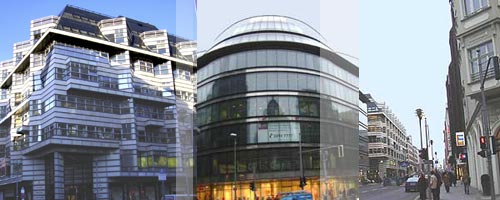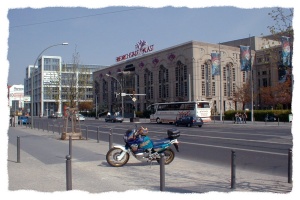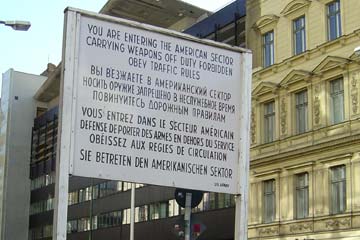












![]() Friedrichstraße Berlin-Centre
Friedrichstraße Berlin-Centre![]() The historical Friedrichstraße is again Berlin's first address. Once Berlin's liveliest mile, now it attracts again with luxury and elegance, with extravagant architecture, with great creative building results, with shopping-temples, many cafés, bars and restaurants, with culture, opera, theatre, variety shows. Outstanding are the three complexes of the Friedrichstadt-passages interlinked through underground passages, which were newly built by different star architects. The glass palace of the shopping centre Galeries Lafayette (quarter 207) built after planes by Jean Nouvels, impresses with its funnel- shaped huge refractive glass cone inside, which penetrates the sales areas of all floors. French fashion, noble perfume, French delicacies and little food stalls on the ground floor, noble kitchen accessories and all that can be found at the Galeries Lafayette. Quarter 206, nobly designed with a halo with marbled mosaics, with scissor-type balustrades, with noble boutiques from Prada to Gucci at the department store. One can buy antiques and art or just enjoy an espresso in arty noble atmosphere. At the Bauhaus style quarter 205, square, practical, good important companies, medical institutes and the Coca-Cola headquarter have settled here. On the ground floor and in the basement, many shops, restaurants, a place for a short rest after shopping or time for a business lunch and room for culture can be found. Big companies and banks have built their branches again at the Friedrichstraße, supplemented by solicitor's offices, car showrooms, hotels, restaurants also designer-ateliers, bookstores, the Kulturkaufhaus Dussmann. Life and flair have moved in again into the Friedrichstraße.
The historical Friedrichstraße is again Berlin's first address. Once Berlin's liveliest mile, now it attracts again with luxury and elegance, with extravagant architecture, with great creative building results, with shopping-temples, many cafés, bars and restaurants, with culture, opera, theatre, variety shows. Outstanding are the three complexes of the Friedrichstadt-passages interlinked through underground passages, which were newly built by different star architects. The glass palace of the shopping centre Galeries Lafayette (quarter 207) built after planes by Jean Nouvels, impresses with its funnel- shaped huge refractive glass cone inside, which penetrates the sales areas of all floors. French fashion, noble perfume, French delicacies and little food stalls on the ground floor, noble kitchen accessories and all that can be found at the Galeries Lafayette. Quarter 206, nobly designed with a halo with marbled mosaics, with scissor-type balustrades, with noble boutiques from Prada to Gucci at the department store. One can buy antiques and art or just enjoy an espresso in arty noble atmosphere. At the Bauhaus style quarter 205, square, practical, good important companies, medical institutes and the Coca-Cola headquarter have settled here. On the ground floor and in the basement, many shops, restaurants, a place for a short rest after shopping or time for a business lunch and room for culture can be found. Big companies and banks have built their branches again at the Friedrichstraße, supplemented by solicitor's offices, car showrooms, hotels, restaurants also designer-ateliers, bookstores, the Kulturkaufhaus Dussmann. Life and flair have moved in again into the Friedrichstraße. ![]() The Friedrichstraße stretches over a length of 3,3 km in north-south direction across the Berlin centre from the Oranienburger Tor to the Mehringplatz at the Halleschen Tor, separated through the Berlin Wall from 1961-1989, accessible only at the legendary border crossing "Checkpoint Charlie". Allied armed forces, foreigners, diplomats and embassy staff crossed the border here. American and Soviet tanks were standing here face to face in 1961 and created nearly a new war. Today an old DDR customs clearance house and the old warning sign in three languages "You are leaving the American sector" at the border crossing serve as a reminder, as well as the museum house at Checkpoint Charlie in the Friedrichstraße/corner Kochstraße.
The Friedrichstraße stretches over a length of 3,3 km in north-south direction across the Berlin centre from the Oranienburger Tor to the Mehringplatz at the Halleschen Tor, separated through the Berlin Wall from 1961-1989, accessible only at the legendary border crossing "Checkpoint Charlie". Allied armed forces, foreigners, diplomats and embassy staff crossed the border here. American and Soviet tanks were standing here face to face in 1961 and created nearly a new war. Today an old DDR customs clearance house and the old warning sign in three languages "You are leaving the American sector" at the border crossing serve as a reminder, as well as the museum house at Checkpoint Charlie in the Friedrichstraße/corner Kochstraße. ![]() The Friedrichstraße, that is also the former House of Democracy, from 1989 to 1999 Centre of Citizen's Movement, the Russian House of Science and Culture, the International Trade Centre IHZ and the railway station Friedrichstraße. The former central interchange became the end of the line on the 13th August 1961 when the wall was built. The west area became hermetically sealed off for trips from and to West-Berlin and West-Germany for GDR citizens. GDR citizens used the other part of the station. There was an extra customs clearance for entry to the GDR, called the palace-of-tears, where one had to say goodbye to relatives and friends when the entry permit expired. Today, the palace-of-tears has become a popular event place for Berliner and tourists.
The Friedrichstraße, that is also the former House of Democracy, from 1989 to 1999 Centre of Citizen's Movement, the Russian House of Science and Culture, the International Trade Centre IHZ and the railway station Friedrichstraße. The former central interchange became the end of the line on the 13th August 1961 when the wall was built. The west area became hermetically sealed off for trips from and to West-Berlin and West-Germany for GDR citizens. GDR citizens used the other part of the station. There was an extra customs clearance for entry to the GDR, called the palace-of-tears, where one had to say goodbye to relatives and friends when the entry permit expired. Today, the palace-of-tears has become a popular event place for Berliner and tourists.


![]() Directly next to the train station Friedrichstraße is the Admiralspalast situated with the Metropol Theatre. The rebuilding is in full swing. Once a popular amusement temple with cinema, café, ice-rink and luxury bath, later with a theatre, awaits to be used again for culture. The unification congress of the KPD and SPD to SED took place here in 1946.
Directly next to the train station Friedrichstraße is the Admiralspalast situated with the Metropol Theatre. The rebuilding is in full swing. Once a popular amusement temple with cinema, café, ice-rink and luxury bath, later with a theatre, awaits to be used again for culture. The unification congress of the KPD and SPD to SED took place here in 1946.![]() On with culture - the political-satirical cabaret Distel has its traditional stage at the Friedrichstraße. At the Schiffbauerdamm, near the Bertolt-Brecht-Platz is the world-famous Berliner Ensemble BE situated. Brecht's and Weill's 'Three Penny Opera' held here in 1928, its world premiere. The also famous Friedrichstadtpalast was behind the BE at the Am Zirkus 1 until 1985. Once a market hall reconstructed for Max Reinhardt to the "Großen Schauspielhaus" (Great Playhouse) had it to be closed and then pulled down in 1985 due to rotting foundation piles. But a new Friedrichstadtpalast was constructed and opened in 1984, furnished with the most modern stage technique, with ice rinks for ice revues, swimming pools for water ballets. It is also famous for its tap-dancing and classical ballet dancing girl line in colourful costumes.
On with culture - the political-satirical cabaret Distel has its traditional stage at the Friedrichstraße. At the Schiffbauerdamm, near the Bertolt-Brecht-Platz is the world-famous Berliner Ensemble BE situated. Brecht's and Weill's 'Three Penny Opera' held here in 1928, its world premiere. The also famous Friedrichstadtpalast was behind the BE at the Am Zirkus 1 until 1985. Once a market hall reconstructed for Max Reinhardt to the "Großen Schauspielhaus" (Great Playhouse) had it to be closed and then pulled down in 1985 due to rotting foundation piles. But a new Friedrichstadtpalast was constructed and opened in 1984, furnished with the most modern stage technique, with ice rinks for ice revues, swimming pools for water ballets. It is also famous for its tap-dancing and classical ballet dancing girl line in colourful costumes. ![]() Something about the street's history:
Something about the street's history:
The street was used as marching road to the drill ground on the Tempelhof Field at the time of Friedrich Wilhelm. The troops used the road from the manoeuvre to the palace under Wilhelm II. The Friedrichstraße advanced in the imperial Berlin to the first shopping and entertaining street. The first electric tram ran here in 1896 and the Kaisergalerie and the Friedrich Passages were built. The city station Friedrichstraße opened in 1882. Berlin's first market hall the Friedrichstadtpalast, opened in 1869, which was used as a circus from 1874 onwards and changed to the Great Playhouse in 1919. It was the connection around 1900 between government quarter, theatres, banks and press quarter with hotels, operetta houses, beer and revue palaces. Afer 1918, it changed to an eldorado of the Roués, when businessmen started to settle on the aspiring Kurfürstendamm.![]() Transport Links:
Transport Links:
U-Bahn: Friedrichstraße
S-Bahn: Friedrichstraße
Tram: 1, 50
Bus: 147